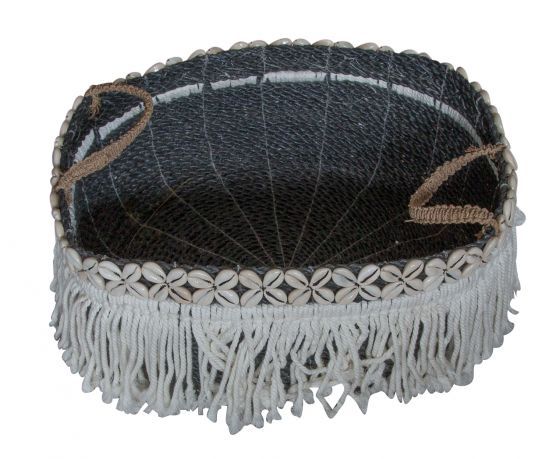We use cookies to make your experience better.
Papua large storage basket with beautiful macramé work, made entirely by hand.
The Papuans are the original inhabitants of the island of New Guinea and some neighboring islands. They live in two countries; Indonesia (the provinces of Papua and West Papua, together Irian Jaya before 2000) and Papua New Guinea. In addition, due to emigration, Papuans live in the western world, especially in the Netherlands. New Guinea is inhabited by nearly a thousand different tribes and is spoken by almost an equal number of different languages, which are divided into two language groups, a very diverse group of Papuan languages and the Austronesian languages. The speakers of the Papuan languages, the largest group, live mainly on the island of New Guinea and the speakers of the Austronesian languages mainly live on the islands of the north and east coast of New Guinea and in a narrow coastal strip of New Guinea. Papuans usually refer to the speakers of the Papuan languages, but sometimes they also include the Austronesian-speaking minority. The Austronesian-speaking tribes are also referred to as Melanesians, after Melanesia, of which New Guinea is a part.
Recent evidence shows that the Papuans are descendants of the first group of residents to settle in New Guinea. These original inhabitants came at a time when the island was connected to the rest of the Australian continent by a land bridge. These people had crossed the then narrower strait from the islands of Wallacea and Sundaland, the present day Indonesian Archipelago. Archaeological finds have shown that the island was first inhabited at least 40,000 years ago, some 10,000 years after the first modern humans left Africa. The ancestors of the Austronesian peoples came much later, about 3,500 years ago, as part of the gradual migration of seafaring peoples from Southeast Asia, which may have originated in eastern China. Austronesian-speaking peoples colonized many of the islands off the north and east coast of New Guinea, such as New Ireland and New Britain, as well as off the coast of New Guinea. Inhabitation over tens of thousands of years has resulted in a great diversity of peoples and languages, which was further increased by the arrival of the Austronesians and in recent history the colonization of Europeans and Indonesians. The western part of New Guinea was part of the Dutch colony of the Dutch East Indies from the end of the nineteenth century until the independence of Indonesia in 1949. Between 1949 and 1962 it was an overseas territory of the Netherlands under the name of Dutch New Guinea. After six months under the administration of the United Nations (UNTEA), this part of New Guinea was transferred to Indonesia on May 1, 1963. There it became a province under the name of Irian Barat, and from 1970 Irian Jaya. Nuvola single chevron right.svg See also the section Handover to Indonesia in the article Dutch New Guinea Before the handover to Indonesia and especially afterwards and to date, the Papuans are asking for independence from Indonesia, which they see as the occupier. From 1965 it was the Organisasi Papua Merdeka (OPM) (Organization for a Free Papua) that fought for independence from the interior of the Vogelkop. On July 1, 1971, the OPM proclaimed the independence of the Republic of West Papua. The armed branch of the OPM ceased to exist around this time, even though the OPM is still seen as a symbol of a free Papua. The armed struggle was continued by, among others, the Tentara Pembebasan Nasional (TPN) (National Liberation Army) and the Pasukan Pembebasan Nasional (Papenal) (National Liberation Forces), which are mainly active in the border area of Papua New Guinea. The Papuans are also striving for independence with diplomatic means, including at the United Nations and the American Congress, and continue to demand their right to self-determination. The representatives of the Papuans come together in the Papua Congress.
| Dimensions | 160x430mm |
|---|












